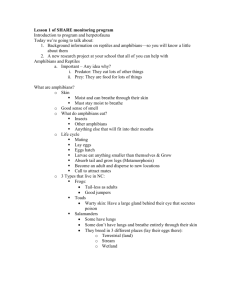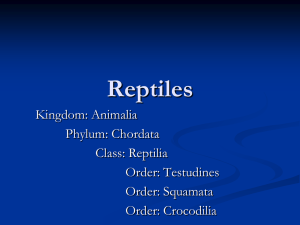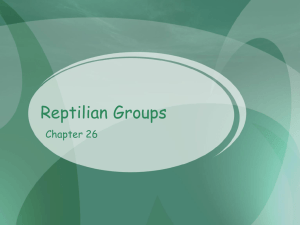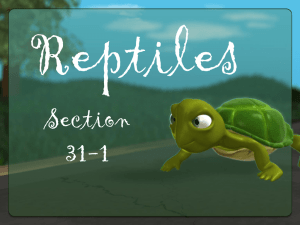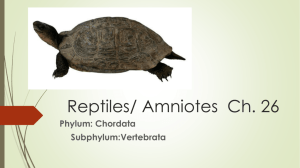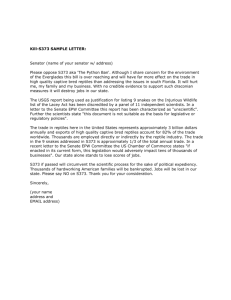Amniote Origins and Reptilian Groups Chapter 26
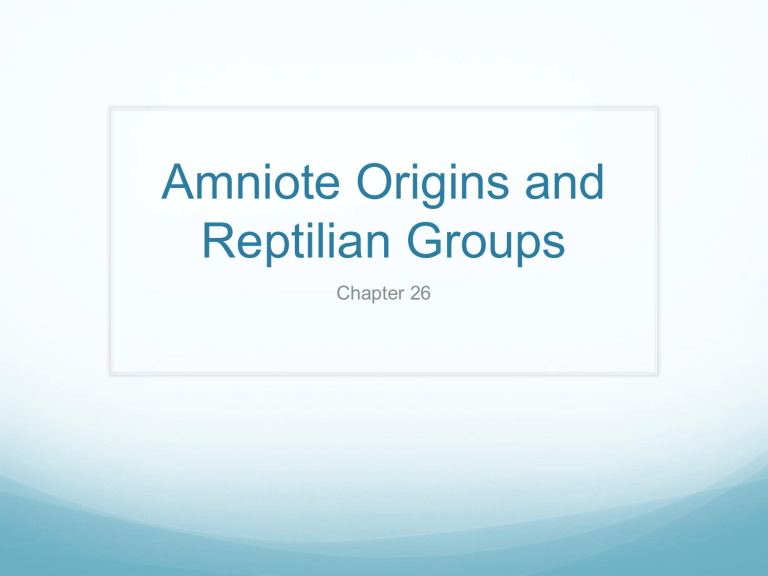
Amniote Origins and
Reptilian Groups
Chapter 26
Amniotes
Amphibians are still closely tied to water because their eggs & usually larvae must be in the water.
The eggs are shell-less and will dry out quickly.
Amniotes
Amniotes are a monophyletic group of tetrapods that have a terrestrially adapted egg.
Reptiles, birds, mammals.
A phylogeny of Amniotes
Amniotes arose from a group of amphibian-like tetrapods, the anthracosaurs , during the early
Carboniferous.
Origin of Amniotes
By the late Carboniferous, skulls of amniotes could be separated into groups based on three patterns of openings (fenestra) in the temporal region.
Anapsids
Diapsids
Synapsids
These openings are associated with large muscles that elevate the lower jaw.
Origin of Amniotes
Origin of Amniotes
Anapsids – skull has no openings in the temple area behind the eye sockets.
The earliest amniotes had anapsid skulls.
Turtles are the only living representatives.
BUT: turtles most likely had diapsid ancestors – so the anapsid condition is secondarily derived.
Origin of Amniotes
Diapsids – two temporal openings.
All other reptile groups and birds.
Four subgroups of diapsids:
Lepidosaurs – includes all modern reptiles except turtles & crocodilians.
Archosaurs – includes dinosaurs, crocodilians, and birds.
Sauropterygians – several extinct aquatic groups, such as plesiosaurs.
Ichthyosaurs – extinct aquatic, dolphin-like forms.
Turtles – placement is still controversial.
Origin of Amniotes
Synapsids – one temporal opening.
Includes mammals and extinct mammal-like reptiles.
The first amniote group to diversify, giving rise to pelycosaurs, theraspids, and then mammals.
Changes in Classification
Reptilia is no longer considered a valid taxon because it is paraphyletic.
Includes common ancestor and some – but not all – of the descendents.
Birds should be included.
Reptiles + birds is a monophyletic group.
Crocodiles & birds are sister groups.
They form a monophyletic group apart from other reptiles.
Archosauria
Reptile Characteristics
Reptiles have tough, dry, scaly skin that protects them from desiccation and injury.
Chromatophores are the color-bearing cells found in the dermis.
Beta keratin is a unique type of keratin found only in reptiles.
Scales are made mostly of beta keratin.
Scales are of epidermal origin, not dermal as in fishes – not homologous.
Reptile Characteristics
Reptiles periodically shed their skin.
Snakes shed in one piece turning it inside out.
Lizards may slough their skin in pieces.
Derived Characters of
Amniotes
Amniotes are named for the major derived character of the clade, the amniotic egg .
This egg contains specialized membranes that protect the embryo.
Derived Characters of
Amniotes
The extraembryonic membranes have various functions.
The chorion and allantois assist in exchange of oxygen
& carbon dioxide with the environment.
The extraembryonic yolk sac provides nutrition for the growing embryo.
The amnion and fibrous or calcareous shell provide support and reduce water loss.
Derived Characters of
Amniotes
Amniotes also have other terrestrial adaptations, such as relatively impermeable skin and the ability to use the rib cage to ventilate the lungs.
Reptile Characteristics
Reptile jaws have more developed musculature and more force can be applied after prey is seized.
Reptile Characteristics
Shelled eggs require internal fertilization and specializations to form the shell.
The circulatory system is more efficient.
The atrium is completely divided.
Ventricle is at least partially divided.
Completely divided in crocodilians.
Reptile Characteristics
Reptilian lungs are better developed than those of amphibians.
Reptiles suck air into their lungs by enlarging the thoracic cavity.
Snakes and lizards expand the rib cage.
Crocodilians and turtles move internal organs.
Reptile Characteristics
Reptiles, and other amniotes, have a kidney specialized to concentrate solutes in the urine, conserving water.
Reptiles that have legs have better body support than amphibians.
Legs better designed for moving on land.
Reptile Characteristics
Reptilian nervous systems are more complex than those of amphibians.
This allows for more complex behaviors.
Reptile Characteristics
Sense organs are well developed
(except hearing).
Lizards & snakes have a well developed
Jacobson ’ s organ , a specialized olfactory chamber.
Odors are carried to the Jacobson ’ s organ by the tongue in some.
Order Testudines
Order Testudines – the turtles & tortoises.
An anapsid skull has no openings in the temple area behind the eye sockets.
Turtles & tortoises have a secondarily anapsid skull.
Order Testudines
Turtles appear in the fossil record about 200 mya, during the Triassic.
They have changed little since then.
Turtles are enclosed in a shell consisting of the dorsal carapace and the ventral plastron .
The shell has an outer layer of keratin and an inner layer of bone (including the ribs & vertebrae).
The shell is a very useful protective feature.
Order Testudines
Turtles have their limbs & limb girdles inside the ribs – an adaptation for pulling into the shell.
Turtles do not have teeth, instead they have keratinized plates for gripping food.
Order Testudines
Since the ribs are fused, they can ’t be expanded for breathing.
Turtles use abdominal and pectoral muscles as a
“ diaphragm ” .
Contracting these muscles pulls air into the lungs.
They pull the shoulder girdle into the shell to force air out of the lungs.
Order Testudines
Turtles have acute vision and can see color as well as humans.
They have a good sense of smell.
Turtles have poor hearing and so, do not vocalize much.
Order Testudines
Turtles are oviparous .
Shelled, amniotic eggs are buried in the ground.
Females carefully construct nests, lay their eggs, bury them, and leave them to hatch.
Order Testudines
Some species have temperature dependent sex determination .
Low temperatures produce males.
High temperatures produce females.
These species lack sex chromosomes.
Order Testudines
Sea turtles only come out of the sea to lay their eggs in nests on the beach.
Great care is taken to dig the nest and then disguise it from egg-predators.
Diapsid Reptiles
Living diapsids include
Lepidosaurs
(lizards, snakes, tuataras), and
Archosaurs
(crocodilians).
Diapsid skulls have two pairs of temporal openings.
Order Squamata
Lizards, snakes, and worm lizards are part of the order Squamata .
95% of living reptiles are squamates.
Some squamates are viviparous , no other reptiles are.
Order Squamata
Skulls of squamates are modified from ancestral diapsid skulls by loss of dermal bone ventral and posterior to the lower temporal opening.
This allowed for the evolution of a skull with movable joints
– a kinetic skull .
Assists with seizing & manipulating prey.
More closing force.
Order Squamata
Snakes have extremely kinetic skulls.
The two halves of the lower jaw are joined only by muscles and skin allowing them to spread apart.
The tracheal opening is thrust forward between the two mandibles so the snake can breathe while eating.
Suborder Sauria - lizards
Lizards ( suborder
Sauria ) first appeared in the fossil record in the
Jurassic and began their radiation in the
Cretaceous.
Examples include: geckos, iguanids, skinks, & chameleons.
Suborder Sauria - lizards
Most lizards have movable eyelids, while snakes have a permanent transparent cap that protects the eye.
Lizards, except the nocturnal geckos, have good vision with rods & cones on their retina for color vision.
Suborder Sauria - lizards
Many lizards live in hot and arid regions.
Water loss through the skin is reduced by the lack of glands in the skin.
They produce a semisolid urine high in uric acids.
Suborder Sauria - lizards
Some lizards, like leopard geckos and
Gila monsters, store fat in their tails.
Most lizards have the ability to drop their tails and regrow a new one.
Suborder Sauria - lizards
Lizards, like most reptiles, are ectotherms – they must adjust their body temperature by moving to different microclimates.
Ectotherms use less energy than endotherms (use metabolism to regulate body temp) – this allows them to live in unproductive ecosystems and to survive longer periods without food.
Suborder Amphisbaenia
Amphisbaenians (worm lizards) appear in the fossil record in the
Cenozoic era.
They have specializations for burrowing.
They can move backwards almost as well as forwards.
Eyes and ears are hidden under skin.
This makes them look a lot like an earthworm.
Suborder Serpentes – Snakes
Snakes ( suborder Serpentes ) appear in the late Jurassic.
Derived from a group of lizards whose other descendants include the Gila monster and monitor lizards.
Suborder Serpentes – Snakes
Snakes are limbless and usually lack both pectoral and pelvic girdles.
Remnants of a pelvic girdle can be found in pythons, boas, and a few others.
The vertebrae of snakes are modified to permit quick lateral undulations.
Suborder Serpentes – Snakes
Snakes rely on the detection of chemical cues when hunting.
They have a pair of pit-like organs in the roof of the mouth – the Jacobson ’ s organs . These are lined with chemosensory epithelium.
The tongue picks up scent molecules from the environment and brings them to the Jacobson ’ s organs.
Suborder Serpentes – Snakes
Snakes have a highly kinetic skull that enables them to eat prey several times their own diameter.
Two halves of the lower jaw joined only by muscles and skin.
Suborder Serpentes – Snakes
Snakes usually move using lateral undulation where movement follows an S-shaped path.
https://youtu.be/gbxaC2-o0Gs
Suborder Serpentes – Snakes
Concertina movement enables a snake to move in a narrow passage.
The snake extends forward while bracing S-shaped loops against the sides of the channel.
Suborder Serpentes – Snakes
Heavy bodied snakes use rectilinear movement where parts of the snake rest on the ground, while other parts are off the ground, stretching forward.
Suborder Serpentes – Snakes
Side-winding allows desert vipers to move fast over loose, sandy surfaces with a minimum of surface contact.
The body is thrown forward in loops.
https://youtu.be/JyXNBAHu32o
Suborder Serpentes – Snakes
All snakes are carnivorous.
Most snakes swallow small prey items while alive.
Some constrict their prey first.
Suborder Serpentes – Snakes
Other snakes inject the prey with venom first.
Venom is delivered through a channel in the fangs.
Suborder Serpentes – Snakes
Most snakes are oviparous .
Some are ovoviviparous (including pit vipers) and give birth to live young.
Very few are viviparous with the young receiving nourishment through a primitive placenta.
Snakes can store sperm and may lay several fertile clutches after one mating.
Order Sphenodonta -
Tuataras
Two living species of Sphenodon are the sole survivors of the sphenodontid lineage that radiated modestly in the Mesozoic, but declined along with the dinosaurs at the end of the Mesozoic.
They live only in New Zealand in burrows that they often share with petrels.
Order Sphenodonta -
Tuataras
Tuataras possess many features almost identical to those of Mesozoic animals living 200 mya.
Diapsid skull with two temporal openings bounded by complete arches.
Well-developed median parietal eye – can only register light intensity.
Order Crocodilia
Crocodilians ( order Crocodilia ) are the only surviving archosaur reptiles.
Dinosaurs were also archosaurs.
Birds are descended from one group of dinosaurs.
Order Crocodilia
Today ’ s crocodilians are very similar to those of the early Mesozoic.
There are three families today:
Alligators and caimans (mostly New World)
Crocodiles (widely distributed)
Gharials (1 species in India & Burma)
Order Crocodilia
All crocodilians have an elongate, well reinforced skull and massive jaw muscles arranged to allow a wide gape and rapid, powerful closure.
They have teeth set in sockets – thecodont dentition .
All archosaurs including early birds had this type of dentition.
Order Crocodilia
Crocodilians have a complete secondary palate that allows them to breathe while their mouth is filled with food or water.
This trait is shared with mammals.
Crocodilians have a four-chambered heart with completely divided atria & ventricles.
This trait is shared with birds & mammals.
Order Crocodilia
Mother crocodilians guard their nests against potential egg-predators.
All are oviparous .
Sex is temperature dependent.
Low temperatures produce females.
High temperatures produce males.
The young vocalize when they hatch and the mother will dig them out of the nest.
https://youtu.be/mtuhf_TjMak
Order Crocodilia
The mother includes rotting vegetation in the nest to increase the temperature.
Works like a compost pile.
Extinct Archosaurs
Dinosaurs, along with their descendents, the birds, are placed along with crocodiles in the archosaur clade.
Traditionally, dinosaurs were considered slow, sluggish creatures, but fossil discoveries and research have led to the conclusion that dinosaurs were agile and fast moving.
Extinct Archosaurs
Paleontologists have also discovered signs of parental care among dinosaurs.
Living archosaurs (crocodilians & birds) also show parental care.
Extinct Archosaurs
Order Saurischia – “ lizard-hipped ”
Suborder Sauropodomorpha – herbivorous long necks.
Suborder Theropoda – carnivores like T. rex and
Velociraptor .
Birds evolved from theropod dinosaurs.
Order Ornithischia – “ bird-hipped ”
Stegosaurus , Triceratops , Parasaurolophus
